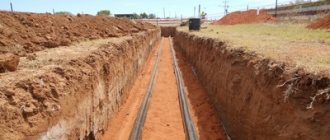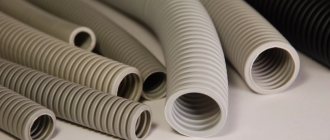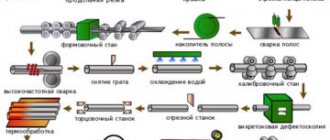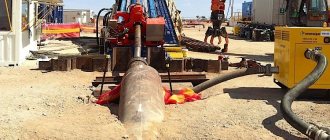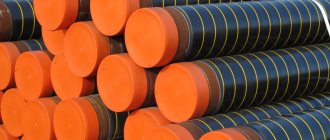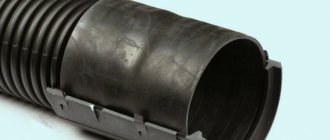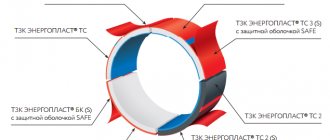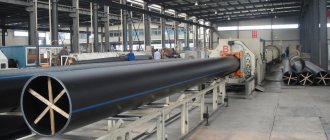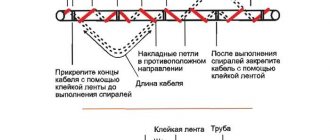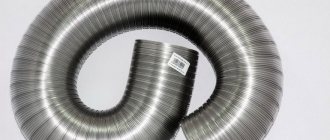There are many ways to protect electrical wiring from external influences. The cable is covered with a durable sheath, walled up in the wall, and hidden behind a suspended ceiling. Finally, they are placed in special plastic boxes. All these methods really increase the survivability of the wiring, but do not protect it from mechanical stress. For example, drilling a wall, hitting with a chisel or an ax, displacing load-bearing structures, passing vehicles. The only way to make the power wiring installation self-protective is to use steel wiring pipe.
Not to be confused with steel corrugation. This method of protection is also not bad, but thin-walled corrugation is not so strong.
Installing electrical wiring in pipes really solves many problems, but the cost of organizing energy supply increases significantly. The electrical installation rules (PUE) do not provide for the conditions under which laying a cable in a metal pipe becomes mandatory. However, in practice there are situations when the safety requirements of the PUE can only be implemented by organizing cable wiring in metal pipes.
Why are wires laid in pipes?
Pipes protect cables from mechanical damage. Protection is relevant both for underground laying of communications and for open installations - outdoors and indoors. Damage to the insulation can lead to short circuits and the emergence of voltage on building structures (metal engineering systems are especially worth highlighting) and in the soil near the damaged line. The consequence of these problems is a disruption in the power supply of the facility or a danger to human life and health.
Manufacturers and prices: is there a difference?
Here you must immediately understand that the main component of the cost is the amount of material spent on manufacturing. Plus transportation costs. The higher the quality of the plastic, and the more of it in the finished structure (the thicker and stronger the walls), the higher the price. Just like with cable, where the main pricing factor is the quantity and quality of copper.
And exactly the opposite: the lowest price will be for cheap plastic of dubious performance characteristics, which is also slightly under-produced.
Don't buy the cheapest noname!
As Evgeniy explained, the game of saving is not worth the candle. The difference in price between low-quality products from unknown manufacturers, with which the markets are flooded (especially a lot of penny corrugation), and factory-certified goods is insignificant.
So, you can buy a coil of normal pipe for installing internal electrical wiring for about 200 UAH. (focus on brands no less than the level of Kopos, DKC, IEK). And for something you don’t understand, you’ll pay 170-175 UAH at the market.
On volumes for the entire apartment, you will save 25 hryvnia - in absolute terms, a penny benefit is not worth the risks.
What exactly are the risks that come with a low price tag?
Firstly, no-name products without certificates and documents confirming their origin more than likely have defects that contradict the standards. Damage, ruptures, sagging, swelling, and delamination of the material are possible. As a result, a low degree of wear resistance and a high degree of fragility. The big question is the amount of plastic itself - perhaps they saved money on the thickness of the walls, and whether such corrugation is able to fulfill its function is unknown.
Related articles: Inverters and UPS in Moscow
Secondly, the quality of the plastic is unknown. How flammable/non-flammable is it really? I wouldn't want to test this in an extreme situation. What about toxicity? The nameless manufacturer does not provide information about the composition of cheap, non-certified material produced in artisanal conditions. How to make sure that its formula does not contain dangerous plasticizers - phthalates, or lead, formaldehyde, cadmium? And you and your loved ones will live and breathe here for decades.
Therefore, when making electrical installations in a house and laying cables in pipes, it is much more reasonable to lay them in pipes made of durable, non-flammable PVC that does not pose a risk of toxic fumes, which is confirmed by documents. And do this according to certain rules.
What kind of pipes are used for laying cables in the soil?
For laying cables in the soil, products made from the following materials are used:
- Steel. Traditional, durable, reliable material. Quite durable, but susceptible to corrosion. The optimal choice of steel pipe is galvanized outside and inside. Stainless steel products and corrugation are not used due to their high cost. The service life of such products reaches 50 years. Nowadays corrugated steel pipes with anti-corrosion coating are produced.
- Cast iron. They are used very rarely due to their heavy weight and complex installation. They are most often used in private housing construction - if there are unnecessary materials and it is necessary to draw a line in the ground. The durability of cast iron also reaches 50 years.
- Asbestos-cement. Durable, not subject to corrosion, but fragile. Installation of such products is quite complicated; connecting fittings are not available for them. Laying asbestos-cement communications under roads is undesirable.
- Concrete (reinforced concrete). Durable and non-corrosive, durable. Small diameters are not produced, so they are sometimes used for laying groups of power cables in urban infrastructure. The structure is very heavy, so installation is difficult. More often, concrete cable channels - boxes with a lid - are used for laying power lines. They are more practical, it is easier to repair damage or replace communications.
- Ceramic. They are similar in use and properties to concrete, but are fragile, which further complicates installation. Very expensive.
- Plastic smooth and corrugated, including two-layer ones. Durable, not subject to corrosion and rotting, quite durable. For laying a cable to a private home, this is an excellent option, but in the case of power lines, the strength of the plastic may not be sufficient. But when installed outdoors in homes, it is a wonderful material, inexpensive and easy to install. They usually use low-density polyethylene or polyvinyl chloride; in a private home, polypropylene can also be used. It should be borne in mind that HDPE and polypropylene are not resistant to ultraviolet radiation; only PVC products should be used for open external installation.
There are also copper pipes. Copper is not used for laying in the ground, in walls and in invisible places because of the price. Copper structures are used only for decorative open wiring in interior spaces.
In practice, when laying power lines to a private house, two types of pipes are used: steel or plastic (or corrugated).
How to use cable pullers
The absence of a probe is not an obstacle, since it can be replaced with other devices. Perhaps the process will become a little more labor-intensive, but the result will be achieved. Here are the most common uses of probe alternatives.
Engage UZK
UZK (also known as bush, also known as cable conductor) is a specialized device for laying cable channels.
It is an installation tool with which the cable is pulled through. The ultrasound probe consists of two components: a flexible or rigid nozzle, as well as a fiberglass, nylon or steel rod. If the bush is long enough, a winch or reel for winding is attached to it.
The sequence of actions is as follows:
- The ultrasonic probe is inserted into the pipe.
- The cable is attached to the bush (it is permissible to use a cable stocking).
- The ultrasonic device is pulled out of the pipe, replacing the cable.
To increase the efficiency of the process, winches (hydraulic, electrical or mechanical) are used. To speed up wire pulling and minimize friction, you can add special ointments to the process.
In what case is a metal pipe needed?
No matter how durable modern plastic is, it is inferior to steel. Therefore, metal protective structures are used in cases where there is strong pressure on communications: a road passes over the line, there is a parking lot, a garage entrance, heavy or vibrating equipment is located, there is a danger of ground subsidence, landslides, and earthquakes. In some cases, metal is also used to protect against vandalism (for example, when lowering a cable from a support into the ground), if thieves are operating in the area where your dacha is located.
Metal is used if there is a danger of damage to communications during excavation work.
Laying power lines in steel pipes is used for wiring in hot shops, where there is a risk of sparks, in explosive and fire hazardous areas. In wooden buildings or when installing wires on wooden sheathing, only metal casings are allowed.
Safety requirements when organizing wiring in pipes
When laying power lines in pipes, the following requirements must be observed:
- The depth of the lines must be at least 70 cm - this protects people on the surface of the earth from electric shock if the insulation is damaged.
- It is very important that the diameter of the casing is 2-3 times larger than the diameter of the wiring.
- The distance from the communication line to the foundation is at least 60 cm; lines are not allowed to be drawn under the foundation.
- When laying communications under the road, the distance to the surface must be at least 1 m.
- A warning tape must be installed.
- If possible, it is necessary to step back from the tree roots by at least a meter (when laying without a casing - 2 m).
- The distance to sewerage, water supply, and gas pipelines must be at least 1 m; to the heating system pipeline - at least 2 m.
- There must be a distance of at least 1.5 m to the road curb.
- To “foreign” power lines - at least 50 cm.
- To the power line support - at least 1 m, to the grounding conductors - at least 5 m.
- The minimum distance (vertical) when crossing a pipeline or other cable is at least 50 cm.
- Indoors, metal casings must be reliably grounded (in no case connected to the neutral wire). Protective grounding must be separate for the electrical supply system and for the pipe casings.
What cables are allowed to be used?
To lay communications in protective boxes (in this case, pipes), cables without armored braiding and in double or triple insulation are used. It is, of course, better to use an armored cable, but it costs a lot, so they make do with ordinary ones. For soils that do not have a strong acidic or alkaline reaction, the following products are suitable: AAShP, AAShv, AAB2 and others. For swampy and saline soils, it is better to use AABl, AAShv, AAB2l, ASB, AAPl, ASPl, AAP2l, AAShp, AVBbShv, AVBbShp, APvBbShv.
Advantages and disadvantages of laying in the soil
Advantages of laying power lines in the soil:
- The soil serves to a certain extent as mechanical protection of communications - when laid underground, hurricanes, ice, snow, wind, and the movement of large vehicles are not afraid.
- Sometimes overhead installation is simply impossible - if there is a highway or geological obstacles in the way).
- Neither ill-wishers nor thieves will damage communications; will not be chewed by rodents and will not be damaged by a cluster of sitting birds.
- In the event of a break or short circuit, the earth serves as a grounding conductor - this reduces to a minimum the fire of wiring in the house, the contact of voltage on the building structures and engineering systems (this will protect a person in the event of an accident from injury from electric shock).
- Invisible communications do not spoil the design of the site. This is especially true when distributing lighting around the site or the entrance to the site.
Flaws:
- Excavation work increases the cost of laying communications, requires time, labor and certain efforts to restore the soil surface - the excavated soil will settle for several years. If the mound is leveled, then in a couple of years a groove will appear in place of the trench.
- Laying in pipes is more difficult and more expensive than hanging a cable through the air.
- Pipeline installation also complicates the work.
- When turning communications, you will have to equip a well.
- The most unpleasant thing is that if a cable is damaged, replacing it is quite complicated, takes time, and sometimes is simply impossible (for example, when the soil freezes to a significant depth, it is impossible to dig a trench manually, and digging with an excavator on the site means damaging plantings, sites, possibly a fence or buildings).
What you need to know about sizes: diameters, inches and millimeters
First and foremost: the diameter is selected based on the type of cable to be laid. The most popular sizes in household electrical installations are from 16-20 mm to 50 mm. People who are inexperienced in electrical installations often get confused: what are the dimensions, in millimeters or inches?
It's actually simple. Electrical pipes are not measured in inches, but exclusively in millimeters. Inches are from the area of measuring water pipes and mounting elements for them. And we have already talked about the inappropriateness of their use for electrical installations. And now a few words about the diameter. It is logical that each pipe has walls of a certain thickness and, accordingly, two diameters, internal and external. Which one to take into account?
Perhaps a surprising answer: neither the first nor the second. As my interlocutor explained, you will have to focus on the nominal diameter. This means that the specified size satisfies the requirements of GOST, is suitable for laying the appropriate cable and can be easily combined with fasteners of the same conventional size. That is, the conventional 16 mm in fact may be 15.8 mm, but this diameter will work just as well.
In fact, it is not necessary to know exactly the internal and external diameters; use the conditional one as a guide. Dimensions up to a tenth of a millimeter will be needed in isolated cases - for example, the exact outer diameter, when you need to drill a hole with absolutely no gap. In the vast majority of cases, this information is not necessary.
cable in pipes manufactured by DKC
The procedure and technology for laying cables in the ground
Any work should start with a diagram. This helps to determine the amount of materials and analyze possible difficulties when laying out communications.
Work order:
- They dig a trench.
- Organize a backfill of sand and spill it with water.
- Tighten the wire and lay the pipe. The wire should be laid with some margin in length, at least 2% (more in summer).
- Check with a multimeter for the absence of short circuit and insulation resistance.
- They fall asleep - first with sand, spilled with water, then with earth, lightly compacted on top.
- At a distance of 25 cm from the communication line, a special warning tape with the inscription “Caution, cable” is laid in the ground.
- Re-check for absence of short circuit and insulation resistance.
Construction of the trench
The depth of laying the line is at least 70 cm, under the roadway and parking area - 100 cm. The depth of the trench should be 10 cm greater - the size of the sand cushion. Sand, a non-compactable soil, protects pipes during minor soil subsidence.
Near the building it is allowed to lay a pipe with a cable to a depth of 50 cm (+10 cm for sand). The length of such a section should not be more than 5 m.
How to join two pieces
No way. There should be no wire couplings in the pipe! It is necessary to purchase a cable of sufficient length. Connections can only be made in wells and only with a long length of communications.
The steel boxes themselves are connected by couplings with internal threads, sealed with FUM tape or tow impregnated with red lead, and a lock nut. This connection is considered the most reliable. Sometimes couplings with a wedge cage, steel cuffs with screws, and couplings with sockets are used.
Many fittings are produced for the installation of plastic and corrugated pipes.
How to enter the house
Entering the house through the foundation is not allowed. To enter the house, the cable in a pipe is laid along the wall of the house and enters the house. The structure running along the wall of the house must be grounded.
How to tighten into a corrugation or pipe
The corrugated sleeve usually contains a thin steel wire-probe inside for pulling the wire. A thin wire is either pushed into a steel pipe, then a wire/cable is attached to it and pulled through, or the end of the cable is carefully wrapped with electrical tape and the cable is carefully (can be rotated) pushed through. The uncut end of the cable does not need to be wrapped with anything.
What if there are multiple cables?
The pulling methods are given above, only the ends of the cables are wound together with electrical tape so that a sharp “spout” is obtained. To do this, each subsequent cable is wound at a short distance from the end of the previous one (a couple of centimeters). The diameter of the tube should be 2-3 times greater than the diameter of the cable bundle, then there will be no special problems with pushing. It is best to use the wire method.
Laying cables under the road
The cable should be laid under the road only in a protective cover made of a smooth pipe. The cover must be made from one whole piece; connections using couplings and boxes are not allowed. If necessary, the pipes can be connected by welding.
How to properly lay cables in a wooden house
In a wooden house, bathhouse, or wooden cladding, it is allowed to lay electrical wiring only in metal pipes and corrugated hoses connected by metal junction boxes. The system must be reliably grounded.
Actually, what is the feasibility?
And look for expediency in the “bible” of electrical installation - a regulatory document called “Rules for the construction of electrical installations.” But we promised to explain the basic principles simply and clearly, so we deliver.
Even when there is no direct need regulated by the PUE, installation in protective pipes is justified in many situations. First of all, where it is necessary to create a physical barrier and distance the cable from the surface to the distance specified by the standards. Plus, this reduces the amount of oxygen available to the cable in the event of a fire.
Walls made of plastic or metal (correctly selected for specific operating conditions) can withstand external pressure and are resistant to aggressive substances such as acids and solvents.
It would be a good idea to provide protection for the cable from damage by rodents.
Additionally, the cable in the pipes is protected from possible exposure to moisture. You can’t do without a special reinforced corrugation (I’ll specify which one later) when making a concrete floor screed. Often this method of electrical installation greatly facilitates and speeds up the process of laying communications.
For example, it is more convenient to install several wires assembled in a bundle in one corrugation, plus the replacement of electrical wiring is ensured.
So, the decision was made to lay the wire in the pipe. Before I tell you which ones you need to choose, I’ll note which ones you don’t need to choose.
